Ship Against Sales Transactions
When shipping against Sales Transactions, StarShip retrieves address and item information from Microsoft Dynamics GP.
Initiate a shipment using the Shipping Assistant
This section contains general information for shipping against Sales Transactions.
-
Select a Sales Trx by scanning or typing in the document number. You can also use the magnifying glass icon to browse and select from the list of current documents. Use the filters at the top of the dialog to narrow your search results.
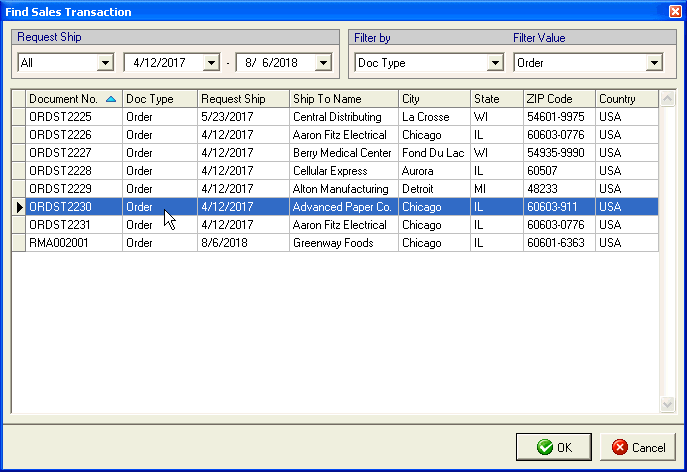
-
If more than one ship-to address is found, you are prompted to select a ship-to. StarShip displays the line items that belong to each ship-to. Make a selection from the drop-down list and click OK.
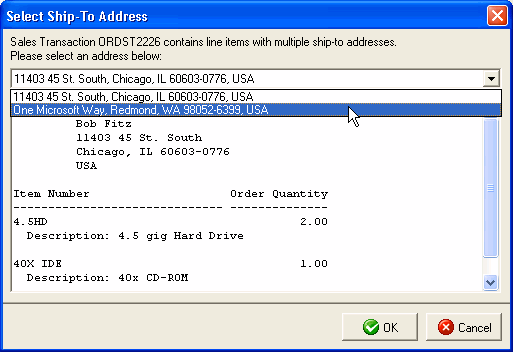
-
Add related orders from the list returned by StarShip, if desired. StarShip allows you to combine multiple orders to consolidate your shipments. Related orders are orders where the "Ship To" address information is the same as the order you selected. They are automatically populated under the "Related Orders" section of the Shipping Assistant when enabled in Financial System Setup. To view details about the related order, select it from the list and its data appears in the main information area. When adding related orders, you can select one or more orders and use the arrow buttons to add them to the shipment.
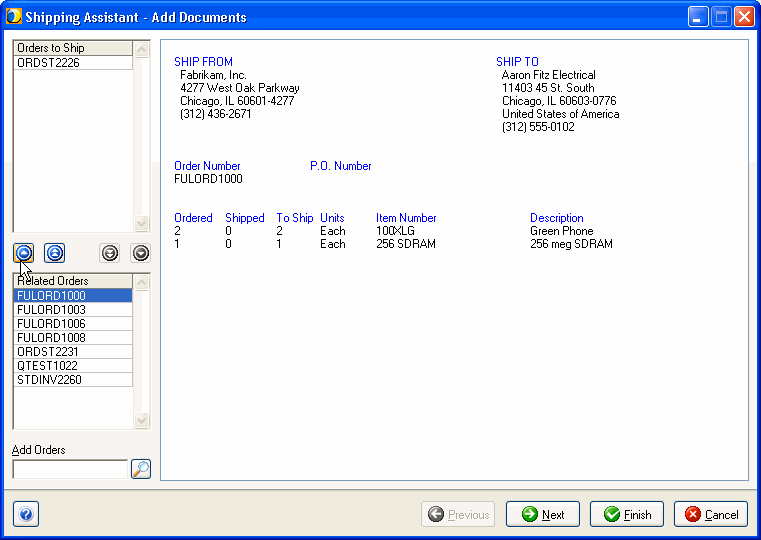
-
Next, enter or edit shipment quantities and classification. If any of the Sales Trx items have previously been shipped, StarShip retrieves related freight information. If items have not been shipped before, you may need to enter additional information such as freight class (unless it is mapped to a field in Dynamics GP).
-
Shipment quantities : StarShip displays the quantity remaining to ship (the order quantity minus the shipped quantity on a currently open document). The "To Ship" column defaults to the quantity remaining to ship, but you can edit or reduce this number. See Notes about Shipment Quantities.
-
Classification : (For Freight shipments) This is where you can specify NMFC code and subcode, class, and group. If you have set up groups in StarShip, you can select the group and the remaining classification data will be automatically populated.
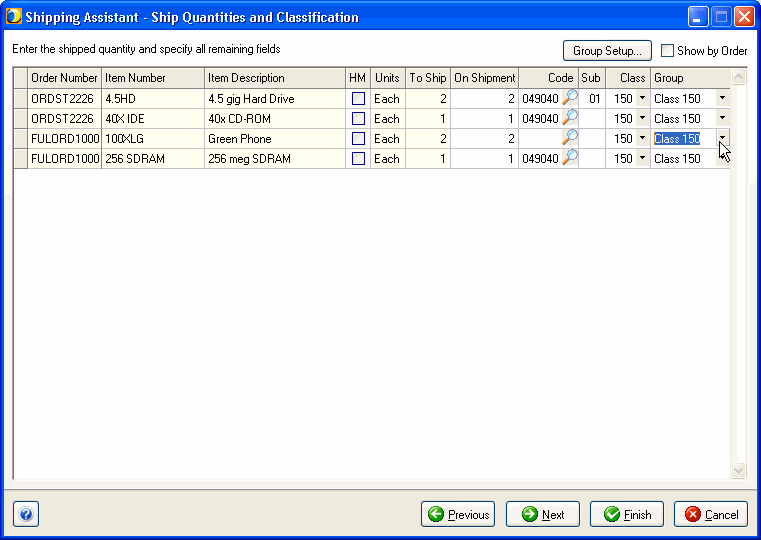
Continue to Ship with item packing or Ship without item packing.
Shipping Assistant with item packing
Within StarShip Freight and Parcel Preferences Setup, there are settings that enable/disable item packing. When you turn on item packing settings, StarShip will pack line items from the Sales Trx using packaging scenarios. StarShip also determines the bill of lading information from the class of the items and how they are packed. Follow these steps to package a shipment when you have item packing enabled :
-
You should now be on the Package Detail window. If you've shipped any of the items before, StarShip retrieves packaging scenarios and automatically packs those items into first level packaging (boxes, cartons, etc.). If items have not been shipped before, drag and drop the items into first level packaging or use .
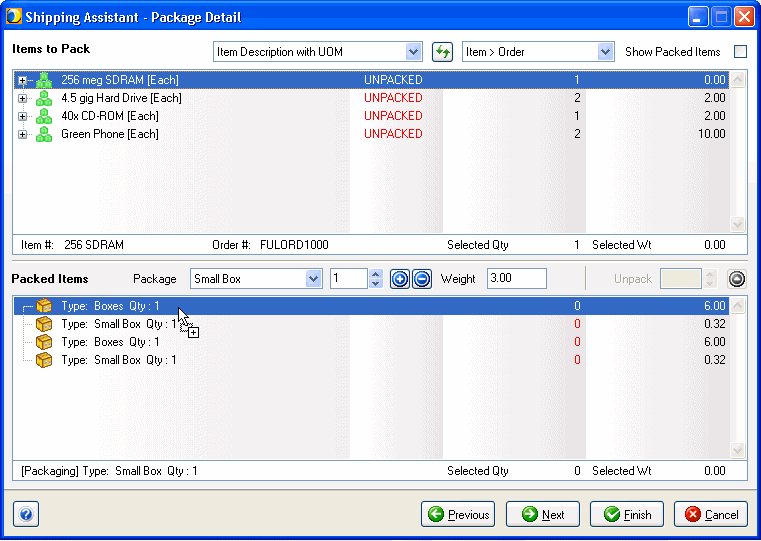
StarShip supports mixed items in one box. However, Starship can only learn packaging scenarios for future shipments when you have one type of item in one package. The auto-learning of packaging scenarios is optional and can be disabled.
-
For Freight shipments, pack the packages onto larger handling units (for example, pallets) using either drag and drop or . Auto-packing is not available for handling units.
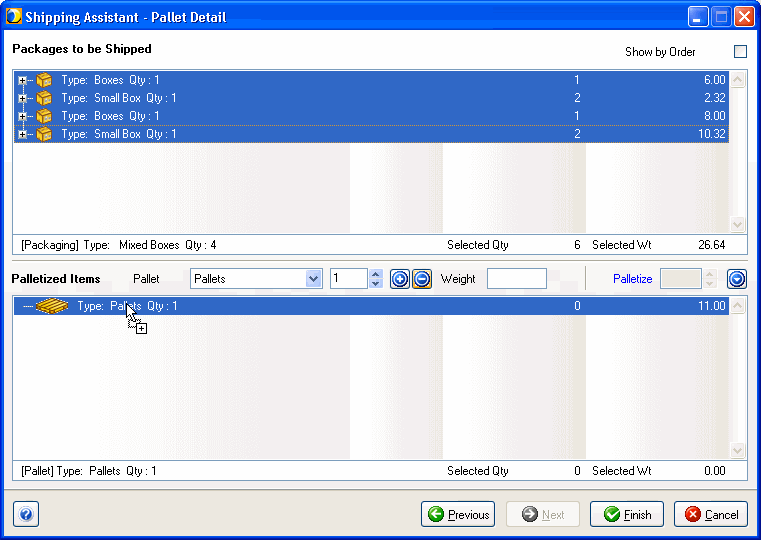
Continue on to Complete the shipment.
Without shipping assistant and item packing
When item packing is disabled, line items from the shipment cannot be packed into boxes and/or pallets in the Shipping Assistant. Follow these steps to package the shipment:
-
Click the Packaging button. In the Packaging View, add packages and drag and drop the items into first level packaging (for example, Box).
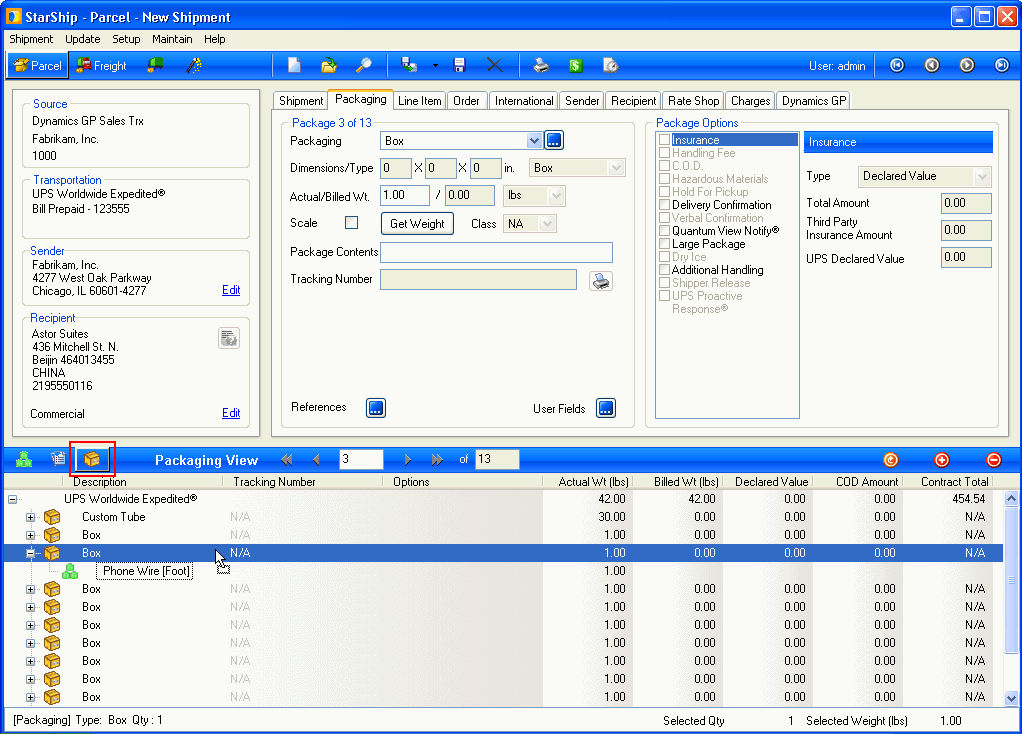
If this is a Freight shipment, click the Add New Pallet button to add handling units and then drag and drop packages onto them. Page through handling units by using the arrows, or by clicking on them.
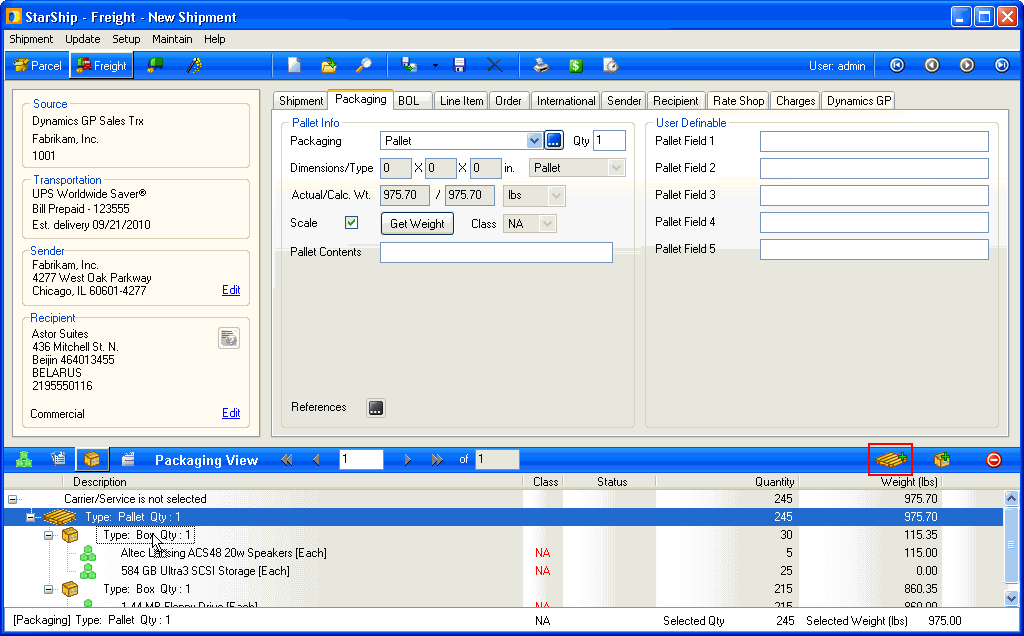
Note: To leave items loose or loose on a pallet, you need to have the following Preferences setup configuration for the BOL :
For Parcel shipments, if you checked the option in Parcel Preferences "When importing orders, pack all loose items into a default package," one default package is added in the shipment detail view.
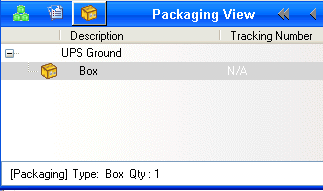
Complete the shipment
-
For Freight shipments, StarShip populates the bill of lading using line item and packing information. Bill of Lading settings in Freight Setup allow you some flexibility regarding how StarShip converts item packaging information into the bill of lading body. Typically, similar items with the same class are grouped under one general description. The commodity description may be edited on the BOL tab.
You can also manually enter the BOL.

For Parcel shipments, you would enter package detail for existing packages. Remain in the Packaging View and navigate through the packages to weigh them or add package level details on the Packaging tab.
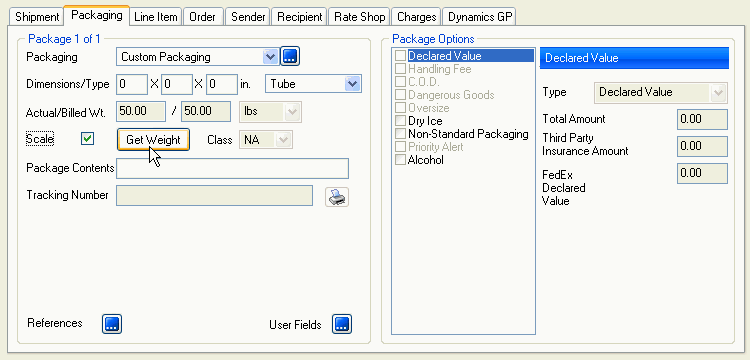
-
Enter or modify the freight billing information of the shipment, if necessary.
-
Select the shipping method - Carrier and Service - on the Shipment tab, and enter shipment detail that was not populated. You can also Rate Shop to select a carrier and service.
-
Rate the shipment with the currently selected carrier by clicking Rate from the File menu or by pressing Ctrl + Alt + R. To rate shop, click the in the toolbar or press Ctrl + Alt + S. Select a carrier from the Rate Shop tab. For more information, see Shipping Process > Rating in the StarShip Help.
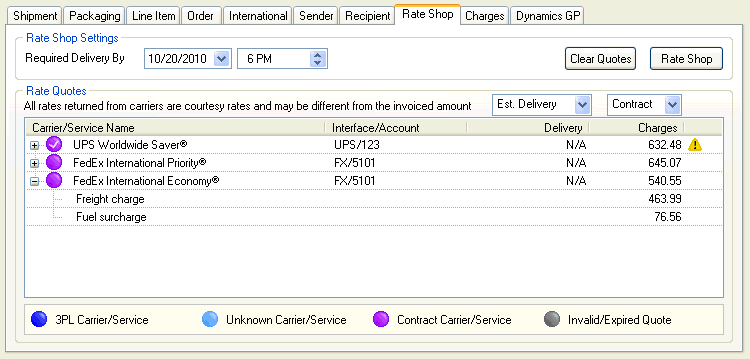
-
If Batch Processing is enabled, StarShip can assign a Batch ID on the Sales Transaction when the shipment is saved. On the Dynamics GP tab, select a Batch ID from the drop-down list, or you can choose not to assign a Batch ID. You must have previously created the Batch ID in Dynamics GP in order for it to appear in the drop-down list.
Your future shipments will use this batch until you change it, or the batch is deleted in Dynamics GP. If you delete the shipment, the batch selected in Financial System Interface Setup > Batch ID Write-Back is used.
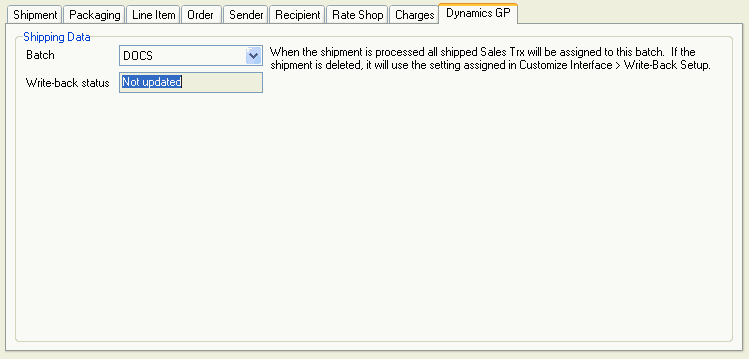
-
Enter the shipment's Ready Date (and Pickup Time, for Freight) on the Shipment tab.
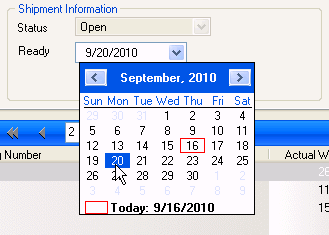
Save the shipment
There are two options for saving shipments.
-
Save: To save a shipment without processing it, select Shipment > Save, press Ctrl + S, or click the Save button on the toolbar. This action saves the shipment as a draft, but does not process the shipment, request pickup from the carrier, automatically print shipping documentation, or write back any information to Dynamics GP. The shipment is essentially saved as a draft so you may open it and make changes.
-
Ship/Process: To process a shipment, select Shipment > Ship/Process or select the Ship/Process button from the toolbar. The shipment is tendered to the carrier. If you set up the bill of lading and/or labels to print automatically, they are now generated.
Shipment Status
Once a shipment is processed, the Shipment Status changes from Open to Processed on the Shipment tab. The status can now be modified.













